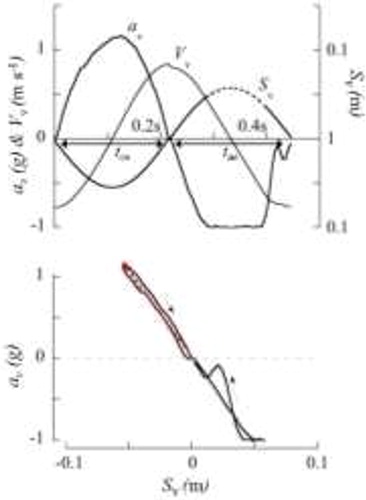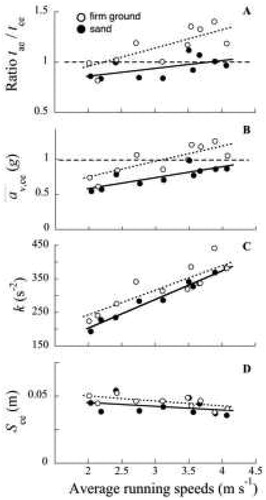1. Introduction
During running, the mechanical energy of the centre of mass of the body (COM) fluctuates throughout the step like a spring-mass system bouncing vertically on the ground. This system oscillates around an equilibrium point at which the vertical acceleration of the COM (av) is nil (Cavagna, Citation2009). The step period can be divided into two parts (): the first part (tce) during which av > 0 (lower part of the oscillation), and the second part (tae) during which av≤ 0 (upper part of the oscillation). At all speeds, tce corresponds to one-half period of the oscillation of the bouncing system, whereas tae corresponds to the second half only if the aerial phase is nil. Indeed, if the body leaves the ground, the elastic model is not anymore valid since av = −1 g.
Figure 1. Typical traces of one subject. Top: Vertical acceleration (av), velocity (Vv) and displacement (Sv) of the COM as a function of time, while running in the sand at 2.5 m s−1. Bottom: av as a function of Sv.

When running on the level, the vertical momentum lost and gained during tce must equal those during tae, i.e. a̅v,cetce = a̅v,aetae, where a̅v,ce and a̅v,ce are the average vertical acceleration during tce and tae, respectively. On a firm terrain at speeds up to ∼3.1 m s−1, the rebound is symmetric, i.e., tce∼tae as in . As speed increases above 3.1 m s−1, tae becomes progressively greater than tce. This asymmetry arises from the fact that, when speed increases, a̅v,ce becomes greater than the acceleration of gravity (g) whereas a̅v,ae cannot exceed 1 g. Consequently, a longer tae is necessary to dissipate and restore the momentum lost and gained during tce.
At low speeds, the symmetrical rebound, named by Cavagna (Citation2009) ‘on-off ground symmetry’ has the physiological advantage to result in a maximal efficiency of positive mechanical work production most likely due to an optimal storage-release of elastic energy into the muscle-tendon unit (Cavagna et al. Citation1997). At high speeds, the ‘on-off ground asymmetry’ has the physiological advantage to reduce the step frequency and thus to limit the power spent to reset the limbs at each step (Cavagna et al. Citation1997). Cavagna (Citation2009) hypothesized that this asymmetry is obtained by an increase of the vertical push, which in turn results from an increase in the vertical stiffness of the spring-mass system. Indeed, a greater vertical stiffness privilege the role played by tendon in the storage-release of elastic energy into the muscle-tendon unit (Cavagna Citation2009).
As compared to running on a firm ground, running in the sand requires additional work to replace the energy lost in the sand at each step. As a result, muscles perform more positive than negative work (Lejeune et al. Citation1998). Such imbalance may affect the vertical stiffness of the bouncing system (Dewolf et al. Citation2016) and in turn the on-off ground symmetry (Cavagna Citation2009). In particular, we expect that in order to contain the increase in muscular work during tce, a̅v,ce will be smaller than on firm ground, leading to a smaller vertical stiffness. Consequently, the on-off ground symmetry would be preserved at fastest speed than on firm ground.
2. Methods
Data were collected on four subjects (age 39 ± 4 years, height 1.81 ± 0.05 m, mass 76.8 ± 7.2 kg; mean ± S.D.) running at different speeds between 2 and 4 m s−1 on firm ground by Willems et al. (Citation1995) and on sand by Lejeune et al. (Citation1998). Trials at a given speed were repeated 2–12 times by the same subject.
Measurements were averaged in classes of ∼0.2 m s−1.
In each trial, the vertical component of the force exerted by the feet on the ground was measured using a force platform comprising eight contiguous plates, each plate 0.6 m long and 0.4 m wide that was mounted near the middle of a 40 m straight corridor (Willems et al. Citation1995). For running in sand, a wooden trough was mounted on the plates and filled to a depth of 7.5 cm with fine and dry sand.
From the vertical ground reaction force (Fv), the vertical acceleration (av), velocity (Vv) and displacement (Sv) of the COM were calculated as in Dewolf et al. (Citation2016). The vertical stiffness (k) of the bouncing system was evaluated as the slope of the linear regression between the vertical acceleration and the vertical displacement of the COM during tce (). A two-level ANOVA was performed to determine the effect of speed and ground surface on the running mechanics.
3. Results and discussion
The softness of the ground has a significant effect on the on-off ground symmetry: tae decreases when running on sand as compared to firm ground (F = 25.8; p < 0.001), whereas tce remains similar. When running on firm ground, the rebound is symmetric (i.e. tae/tce ≈ 1) up to 3 m s−1. These results are consistent with those reported in the literature (Dewolf et al. Citation2016).
When running on sand, tae/tce ∼1 over the whole range of speeds (; t = 0.45; p = 0.654), since a̅v,ce remains ≤ 1 g up to 4 m s−1 (). At a given speed, a lower a̅v,ce is obtained by reducing the vertical stiffness k of the lower-limb (F = 8.2; p = 0.005) and the vertical displacement during tce (Sce) as compared to firm ground (). Due to the lower a̅v,ce, Vv at take-off is reduced and the aerial phase is almost nil. Therefore, tae < tce at slow speeds.
4. Conclusions
On firm ground, the bounce presents an on-off ground symmetry up to 3 m s−1. At higher speeds, an on-off ground asymmetry appears to limit the internal power spent to reset the limbs each step. This asymmetry privileges the role of tendon relative to muscle in the storage-release of elastic energy.
When running on sand, extra positive work must be performed to overcome the dissipation of energy occurring in sand. To allow development of a lower force during the push -and in turn a smaller muscular power- with increasing speed, k and Sce remain smaller than on firm ground. Consequently, bounce presents an on-off ground symmetry over a larger range of speed, privileging the role of muscle relative to tendon in the storage-release of elastic energy. Similar modifications of the on-off ground symmetry have already been observed when subject are requested to add positive work in the spring-mass system, for example when running uphill (Dewolf et al. Citation2016). Those observation strongly support the possible relationship between the on-off ground symmetry and the contribution of tendon in the storage-release of elastic energy into the muscle-tendon unit (Cavagna, Citation2009).
Acknowledgements
This study was funded by the Université catholique de Louvain.
References
- Cavagna GA, Mantovani M, Willems PA, Musch G. 1997. The resonant step frequency in human running. Pflugers Arch. 434(6):678–684.
- Cavagna GA. 2009. The two asymmetries of the bouncing step. Eur J Appl Physiol. 107(6):739–742.
- Dewolf AH, Peñailillo LE, Willems PA. 2016. The rebound of the body during uphill and downhill running at different speeds. J Exp Biol. 219(Pt 15):2276–2288.
- Lejeune TM, Willems PA, Heglund NC. 1998. Mechanics and energetics of human locomotion on sand. J Exp Biol. 201(Pt 13):2071–2080.
- Willems PA, Cavagna GA, Heglund NC. 1995. External, internal and total work in human locomotion. J Exp Biol. 198(Pt 2):379–393.

